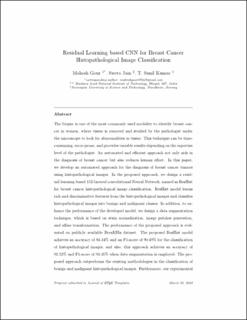| dc.description.abstract | Biopsy is one of the most commonly used modality to identify breast cancer in women, where tissue is removed and studied by the pathologist under the microscope to look for abnormalities in tissue. This technique can be time-consuming, error-prone, and provides variable results depending on the expertise level of the pathologist. An automated and efficient approach not only aids in the diagnosis of breast cancer but also reduces human effort. In this paper, we develop an automated approach for the diagnosis of breast cancer tumors using histopathological images. In the proposed approach, we design a residual learning-based 152-layered convolutional neural network, named as ResHist for breast cancer histopathological image classification. ResHist model learns rich and discriminative features from the histopathological images and classifies histopathological images into benign and malignant classes. In addition, to enhance the performance of the developed model, we design a data augmentation technique, which is based on stain normalization, image patches generation, and affine transformation. The performance of the proposed approach is evaluated on publicly available BreaKHis dataset. The proposed ResHist model achieves an accuracy of 84.34% and an F1-score of 90.49% for the classification of histopathological images. Also, this approach achieves an accuracy of 92.52% and F1-score of 93.45% when data augmentation is employed. The proposed approach outperforms the existing methodologies in the classification of benign and malignant histopathological images. Furthermore, our experimental results demonstrate the superiority of our approach over the pre-trained networks, namely AlexNet, VGG16, VGG19, GoogleNet, Inception-v3, ResNet50, and ResNet152 for the classification of histopathological images. | en_US |
